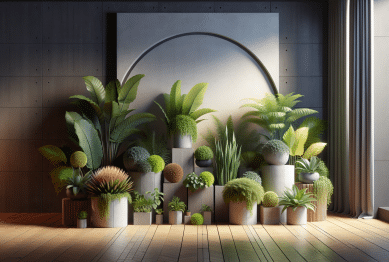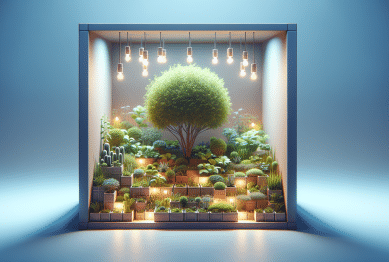Imagine enjoying a beautiful garden that thrives with minimal effort. Low maintenance landscaping transforms your outdoor space, reduces stress, and increases property value. This guide explores practical techniques, popular drought-tolerant plants, sustainable design ideas, and easy-care garden tips to keep your yard lush and manageable all year round.
Why Low Maintenance Landscaping Is Gaining Popularity
Low maintenance landscaping appeals to homeowners who want a vibrant, enjoyable yard without the hours of upkeep. The concept focuses on reducing time and money spent on tasks like frequent mowing, watering, and weeding. Many people today face busy schedules that leave little energy for traditional gardening chores. This approach encourages thoughtful planning and plant selection, so gardens look great using less water, fewer chemicals, and minimal intervention. With unpredictable weather patterns and increasing drought conditions, strategies that promote water conservation are more important than ever. Homeowners seeking a sustainable lifestyle appreciate these benefits and the positive impact on resources and the environment.
Another reason for its popularity stems from a desire to create eco-friendly outdoor spaces. Sustainable landscaping incorporates native or drought-tolerant plants, efficient irrigation, and organic mulches. These methods work together to foster healthier soil and ecosystems. Homeowners are seeking ways to reduce pesticide and fertilizer use, resulting in less runoff and pollution. The popularity of native plants is growing fast since they attract pollinators and require less intervention once established. Integrating hardscapes, such as stone paths or gravel beds, also limits the space that needs attention, making gardens easier to manage and more cost-effective in the long run.
The lifestyle benefits can’t be ignored either. Low maintenance yards provide aesthetic value while freeing up time for family, leisure, or relaxation. Instead of labor-intensive work, homeowners spend more time enjoying their outdoor area. From boosting curb appeal to improving mental health and wellness, the trend is here to stay. As real estate experts point out, homes with attractive landscaping often sell faster and at higher values. Choosing smart landscaping not only simplifies care but can also be a wise investment decision (Source: https://www.epa.gov/greenacres).
Essential Principles for Low Maintenance Garden Design
Creating a low maintenance landscape starts with solid planning and design. The goal is to minimize repetitive chores while maximizing the beauty and functionality of the space. One of the most important principles is selecting the right plant for the right place. Consider factors such as sunlight, soil type, and moisture before planting. Grouping plants with similar needs ensures optimal growth and reduces stress on your landscape. Incorporating ground covers, mulch, and perennial beds can further reduce weed growth and water demand. These foundational decisions pay off over time, resulting in a yard that’s both attractive and simple to maintain (Source: https://extension.umn.edu/lawns-and-landscapes/low-maintenance-landscapes).
Strategic use of hardscape elements is another key component. Patios, walkways, and decorative stone create inviting spaces for gathering or walking while lessening the area that requires mowing or watering. Raised beds and defined borders also help keep gardens organized and reduce encroachment from invasive grass or weeds. Edging materials, such as bricks or recycled plastics, not only add visual interest but also save effort on lawn care. When thoughtfully planned, these features blend seamlessly with plantings to deliver a cohesive, polished look.
Simplicity is at the core of low maintenance design. Avoid overcrowding by spacing plants appropriately, which allows for airflow and discourages pests and disease. Consider incorporating automatic irrigation systems or drip lines to simplify watering. Using native plants suited to the local climate naturally reduces ongoing maintenance. A simple, uncluttered approach creates a calming space that requires less work and provides long-lasting enjoyment throughout the year.
Best Drought-Tolerant Plants for Easy Care Gardens
Choosing drought-tolerant plants is a smart way to minimize watering needs and ensure your garden remains resilient during dry spells. Popular options include ornamental grasses, succulents, coneflowers, and lavender. These species thrive in various soil conditions, bringing color, texture, and movement to the yard. Many drought-tolerant plants developed deep root systems, making them less dependent on frequent irrigation. This characteristic helps conserve water while maintaining a lush appearance (Source: https://www.epa.gov/watersense/drought-tolerant-landscaping).
Native plants are particularly effective in easy care landscaping. They are adapted to local rainfall and climate, which means less work for gardeners and fewer added resources. Favorites include black-eyed Susan, purple sage, yarrow, and California poppy. Not only do native plants require less maintenance, but they also contribute to local biodiversity by attracting beneficial insects, birds, and pollinators. Mixing native flowers with structural elements like juniper or dwarf shrubs adds year-round interest and ensures straightforward care for even novice gardeners.
Perennials offer another excellent choice for low maintenance yards. Once established, perennials come back each year with minimal intervention. Daylilies, sedums, and Russian sage are common selections that flourish with little attention. Their hardiness reduces the need for seasonal replanting, saving both time and money. These dependable plants fill out beds and borders seamlessly, providing attractive foliage and blooms through much of the season.
Simplifying Garden Care with Mulch and Ground Covers
One of the simplest ways to cut down on garden chores is through the application of mulch. Organic mulches—such as wood chips, bark, or compost—retain soil moisture, regulate soil temperature, and suppress weed growth. Spreading mulch reduces evaporation, so garden beds stay hydrated longer. It also slowly breaks down, enriching the soil and boosting plant health naturally. For homeowners intent on low maintenance, mulching twice a year creates lush, happy plants while minimizing routine upkeep (Source: https://www.gardening.cornell.edu/factsheets/mulch/mulch.html).
Ground covers provide another powerful tool for managing gardens with less labor. These low-growing plants, such as creeping thyme, ajuga, and pachysandra, spread out to fill empty spaces and crowd out weeds. They require little mowing and can withstand foot traffic, making them especially useful in walkways or under trees where grass may struggle. Once established, ground covers create a self-sustaining, attractive carpet that eliminates much of the work associated with open garden beds.
Using a combination of mulch and ground covers helps maintain soil health and moisture levels. Together, these methods drastically reduce watering, weeding, and fertilizing needs. In challenging locations or problematic slopes, establishing these layers can prevent erosion and keep your property looking tidy. It’s an easy upgrade that provides both aesthetic value and lasting results without intensive commitment.
Water-Wise Irrigation for Sustainable Landscapes
Irrigation systems play a crucial role in maintaining healthy landscapes with minimal waste. Drip irrigation delivers water directly to the root zone of each plant, ensuring efficiency and reducing evaporation. This targeted approach helps conserve water, a key principle in modern low maintenance garden design. Timers and soil moisture sensors can automate watering schedules, further reducing the need for manual checks and adjustments (Source: https://www.fs.usda.gov/features/using-water-wisely-your-landscape).
Rainwater harvesting offers another water-wise solution for home gardens. Collecting rain in barrels or cisterns provides a free, sustainable source for irrigation during dry periods. Directing downspouts into planting beds ensures rainwater is used where it’s needed most. These approaches work together to save resources, lower utility bills, and support healthy plant growth throughout the year.
Proper scheduling is critical for any irrigation system. Watering early in the morning or late in the evening reduces loss from evaporation. Regularly inspecting your system for leaks and adjusting times for seasonal changes optimizes efficiency. By investing in smart irrigation, homeowners can enjoy thriving gardens with less daily effort and a reduced environmental footprint.
Practical Tips for Effortless Yard Maintenance All Year
Consistency and planning are key to maintaining a low maintenance garden. Begin each season by inspecting for weeds, pests, or disease. Prompt attention to problem areas prevents the need for more time-consuming repairs later on. Dividing and transplanting overgrown perennials revitalizes beds while keeping plants in check. Staying on top of these small tasks, rather than letting chores pile up, promotes ongoing success with less effort overall. Many garden experts recommend making a simple list of bi-monthly tasks. These could include checking mulch depth, pruning, or clearing fallen leaves. Breaking work into small, regular steps transforms maintenance from a chore into a manageable routine even for those new to gardening.
Investing in quality tools adapted to your needs pays off in the long run. Lightweight pruners, ergonomic shovels, or easy-push mowers save both time and energy. Keeping equipment clean and sharp ensures jobs are completed more quickly. For homeowners, the right tools can mean the difference between drudgery and enjoyment. Also, don’t hesitate to contact a local cooperative extension office. These resources offer science-backed information on plant care, soil improvement, and pest management tailored to your specific region (Source: https://extension.psu.edu/low-maintenance-landscaping).
Finally, embrace flexibility and experimentation in your yard. Not every change works perfectly on the first try. Swap out struggling plants for better performers, or adjust your watering routine based on how well your garden responds. Documenting what succeeds and what doesn’t helps refine your approach over time. With patience and curiosity, creating a stress-free, enjoyable landscape is achievable for any home.
References
1. U.S. Environmental Protection Agency. (n.d.). Greenacres: Landscaping with Native Plants. Retrieved from https://www.epa.gov/greenacres
2. University of Minnesota Extension. (n.d.). Low Maintenance Landscapes. Retrieved from https://extension.umn.edu/lawns-and-landscapes/low-maintenance-landscapes
3. EPA WaterSense. (n.d.). Drought-Tolerant Landscaping. Retrieved from https://www.epa.gov/watersense/drought-tolerant-landscaping
4. Cornell University. (n.d.). Mulch Fact Sheet. Retrieved from https://www.gardening.cornell.edu/factsheets/mulch/mulch.html
5. U.S. Forest Service. (n.d.). Using Water Wisely in Your Landscape. Retrieved from https://www.fs.usda.gov/features/using-water-wisely-your-landscape
6. Penn State Extension. (n.d.). Low Maintenance Landscaping. Retrieved from https://extension.psu.edu/low-maintenance-landscaping









